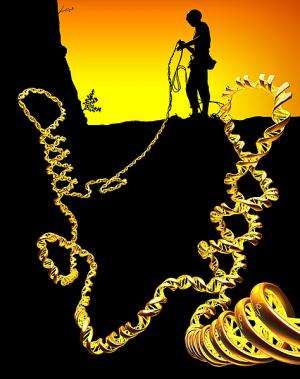Research: Hopping DNA supercoils

If you take hold of a DNA molecule and twist it, this creates 'supercoils', which are a bit like those annoying loops and twists you get in earphone cables. Research carried out by TU Delft, The Netherlands, has found that in the DNA molecule these coils can make their way surprisingly quickly along the length of the DNA. This newly discovered 'hopping' mechanism - which takes places in a matter of milliseconds - could have important biological implications, because cells use the coils to bring specific pieces of DNA into contact with one another. The researchers from Cees Dekker's group at the Kavli Institute of Nanoscience in Delft will be publishing their results in Science this week.
Supercoiling
A DNA molecule in a cell is not simply a loose wire; it is completely wound up in a tangle of loops ('DNA supercoils'). These supercoils in a DNA molecule (see the illustration on the right) are similar to those annoying loops and twists you often get in earphone cables.
In living cells, the DNA supercoils form and unravel and move along the DNA molecule. They are vital to the regulation of DNA activity, in determining which genes are switched on or off for example. One of the ways in which cells use the supercoils is to bring pieces of DNA into contact with one another.
Dynamic
Static images of the DNA supercoils have been studied in detail in the past, but their dynamics remained unknown up till now. PhD student Marijn van Loenhout from the Kavli Institute of Nanoscience at Delft developed a new technique that enabled him to observe how the coils travel along a DNA molecule for the first time. The research was led by Professor Cees Dekker, head of the Bionanoscience Department.
The TU Delft team used magnetic tweezers to stretch out a small section of a DNA molecule and were then able to observe the movement of the DNA coils using fluorescence microscopy (see movies at the website). They succeeded in showing these movements in real time, at the level of the individual DNA molecule.
Hopping coils
Van Loenhout: "We have discovered that the coils can move slowly along the DNA via diffusion. But what we also saw - and this was totally unexpected - that they can 'hop' along relatively long distances (micrometres). In such a movement a loop disappears in one spot, while simultaneously another loop appears in another spot, much further away. This information enables us to test theories about the mechanics of DNA, testing how you tie a knot in DNA, as it were."
TU Delft's Professor Cees Dekker: "The newly discovered 'hopping' mechanism could have important consequences; after all, the mechanism makes it possible to rearrange the genome over a long distance and within a matter of milliseconds. A surprising observation."
Enthusiastic
The research carried out by TU Delft will be published in Science this week. Cees Dekker: "We have presented this work before at conferences; recently at Stanford University's Bio-Engineering Department, for example. The response was overwhelmingly positive. It is after all the first study into the dynamics of DNA supercoiling and may have important implications for research on the many cell processes that are based on spatial rearrangement of the genome."
Dr William Greenleaf of Stanford University's School of Medicine: "These experiments are reminiscent of some of the foundational experiments of single molecule biophysics, such as that of Steven Chu and others, who used fluorescence to make DNA visible. The new method developed by the Delft team makes it possible to observe supercoils in DNA molecules, which provides a unique insight into the properties of twisted DNA. The work presents exciting and potentially fundamental discoveries regarding the physical nature of genetic material."
More information: The TU Delft research on DNA supercoiling will be published on 13 September 2012 in the online express edition of Science.: Dynamics of DNA Supercoils. M.T.J. van Loenhout, M.V. de Grunt and C. Dekker.
Journal information: Science
Provided by Delft University of Technology
















